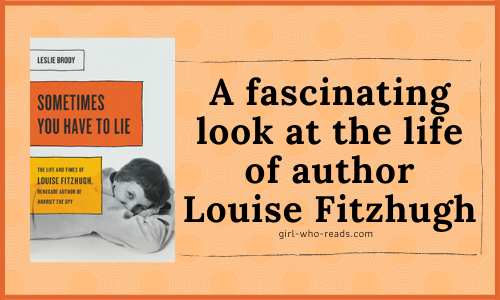by MK French
Louise Fitzhugh published Harriet the Spy in 1964, creating an antiheroine that was unsentimental yet endearing. This was based largely on her own experiences, as she left segregated Memphis for New York City, spent time in lesbian bars of Greenwich Village, and made friends with the avant-garde writers of the day. At the time of publication, Harriet was seen as “nasty” by critics because she didn’t conform to expectations, even if the children reading the book loved her. Louise was told to hide who she really was in order to further her career. Sometimes You Have to Lie seeks to tell Louise’s genuine story.
Amazon affiliate links are used on this site. A free book was provided for an honest review.
 |
| December 2020; Seal Press; 978-1580057691 audio, ebook, print (352 pages); biography |
As with many biographies, we actually get a little background on Louise’s parents first. Partly because they helped shape the woman that she became, and partly to show the reader the time period when she came of age. Her parents were the Jazz Age generation, and forward-thinking for their time: her father was a lawyer from a wealthy and genteel family, and her mother was a dance teacher hoping to support her mother and siblings. Their whirlwind courtship led to a volatile relationship ending in divorce, a scandal for the time, which resulted in Louise’s mother being psychiatrically hospitalized and custody given to her short-tempered father. He told Louise that his mother was dead, and the topic was never openly discussed after the lie was exposed. Louise had many other influences in her life while growing up, leading to a more liberal view of women’s abilities, racial injustice, and the social gaps between rich and poor.
Louise pushed against what was expected of her, hating the whitewashing of her girls’ school, dating a girl as a senior in high school, and having a sexual relationship with a young woman. She also briefly married a male friend in 1947, though it was more to assert her independence from her family than out of a genuine desire to be with a man. Over the years she had several lovers and was a confirmed lesbian, proud of being a groundbreaking artist in the Beatnik era, which was predominantly heterosexual male. She enjoyed friendships with many leading writers, poets, and artists, and chose to start psychotherapy to understand her shifting moods and capricious impulses. That helped stabilize her professional life and work relationship.
I found it fascinating to see how Louise’s life was not only influenced by people she knew, but by the times themselves. The 1950s and 1960s were decades of change and upheaval, and it influenced her art and view of the world. It was a tumultuous era, and Louise’s relationships with lovers, friends, and her mother could mirror that as well. This was not only reflected in her famous novel but in the ways she tried to improve her own knowledge and the relationships she had with her closest friends. It’s also fascinating to see the behind the scenes look at publishing back then, and the struggle over Louise’s literary legacy after she died.
An incredible amount of research went into Sometimes You Have to Lie, not only for Louise but for all the major players in her life. We learn about her parents, her stepmother, the great loves of her life, her friends, her editors, her publishers, and all of the influences she had in the literary and art world of the period. Louise was a believer in using art to reflect the truth of the world at large and make it a better place. Some of the same struggles in race and sexuality still occur, so her struggles to stay true to her art as well as herself still resonates. Because her novel Harriet the Spy is still being discovered by children even now, her biography is a welcome lens to look at the book and how it was influenced, as well as how it reflected on her life and times.
Buy Sometimes You Have to Lie at Amazon
Born and raised in New York City, M.K. French started writing stories when very young, dreaming of different worlds and places to visit. She always had an interest in folklore, fairy tales, and the macabre, which has definitely influenced her work. She currently lives in the Midwest with her husband, three young children, and a golden retriever.
Get even more book news in your inbox, sign up today! Girl Who Reads is an Amazon advertising affiliate; a small commission is earned when purchases are made at Amazon using any Amazon links on this site. Thank you for supporting Girl Who Reads.

.png)

.png)

.png)













Great review, thanks for sharing your thoughts
ReplyDelete